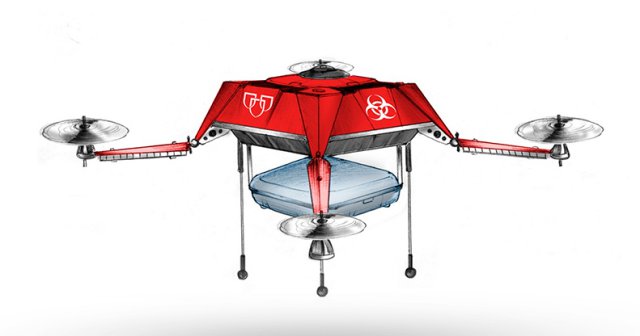In some remote parts of the world, unmanned aerial vehicles (UAVs) are already being field-tested for medical uses. Drones successfully delivered small aid packages after the Haitian earthquake in 2012, and in Papua New Guinea, Doctors Without Borders used them to transport dummy TB test samples from a remote village to the large coastal city of Kerema.
American companies are testing drones in remote areas not only because the need there is great but also because the Federal Aviation Administration (FAA) has so far prohibited using UAVs in U.S. airspace. That will change sometime in 2015, when the FAA issues rules aimed at integrating drones into the National Airspace System. Then, the sky may be the limit for medical applications for drones — at least figuratively.
What drones are and what they can do
Unlike big, multimillion-dollar military drones, the small, rotary-wing aircraft used commercially cost around $10,000 and carry a 5-pound payload for 30 to 60 minutes of flight time, with a range of about 20 to 60 miles. They can be manually operated or preprogrammed to fly specific routes, need almost no room to land, and can even drop packages from a low hover.
The first medical application of UAVs is likely to be disaster relief, where the logistics of distributing blood products is often a bigger problem than supply. The ability of UAVs to travel over closed roads and rugged terrain without risk to a flight crew seems to make them ideal for use in disaster areas.
But Cornelius A. Thiels, D.O., a surgeon at Mayo Clinic’s campus in Rochester, Minnesota, thinks drones will eventually be used to transport blood products to critical access hospitals, mass casualty scenes and even offshore ships with seriously injured passengers.
“Blood is unique because it’s expensive and expires — platelets and thawed plasma last just five days — and the supply is very limited. In our region, the smallest critical access hospitals stock just two to six units of red cells and no fresh frozen plasma or platelets. In medium-sized hospitals, a single patient with massive bleeding can easily deplete the blood supply, and even larger hospitals can run low on certain blood types,” he says.
Large regional hospitals receive daily shipments of blood. Smaller hospitals receive blood weekly and count on larger centers or regional blood banks to restock their supply between shipments. Instead of courier services or the highway patrol transporting blood to a hospital that needs it, a UAV could deliver the blood in advance, taking off as soon as the EMS call comes in.
Drones could also deliver expensive and rarely used drugs, such as antivenin for snake bites, as well as help meet the demand for blood products in the prehospital setting quickly and inexpensively.
“Our advanced transport team makes about 2,000 flights a year and in 2013 delivered more than 200 units of packed red blood cells and 200 units of plasma, so the need for prehospital blood products is clear,” Dr. Thiels says. “Helicopter and even ambulance transport is extremely expensive, whereas the cost of flying a UAV is really low — dollars per trip. Not only are there no fuel, maintenance or pilot costs, there is also no risk to a flight crew.”
Not quite ready for prime time
Although drones hold great promise for medical product transport, the field is still in its infancy. Risks need to be carefully assessed, including the potential hazards of thousands of small aircraft flying, literally, under the radar. Coolers would be required to keep blood products at the proper temperature, and blood would need to be packaged to prevent inadvertent exposure or tampering during transit. Still, these obstacles aren’t insurmountable, and with Google, Amazon and several startups testing drone prototypes at warp speed, commercial UAV transport seems inevitable.
Dr. Thiels thinks there are many more potential applications for drones — delivering defibrillators, for example, or tourniquets and other hemostatic supplies to people injured in mass shootings. “I don’t know how realistic that is, but it’s exciting,” he says.
Source: Mayo Clinic

